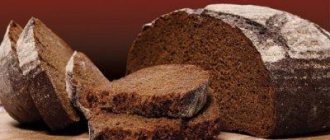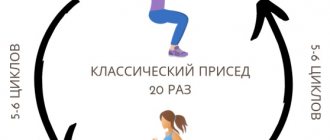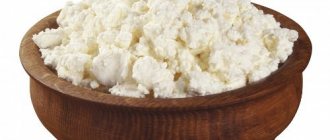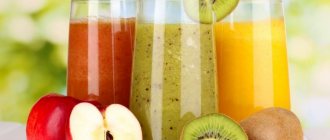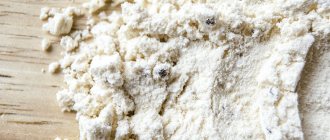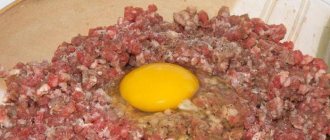Wine has a reputation for being a good drink and, when done well, promotes heart health. While this is true, wine is not the only drink that can benefit the body (and the soul and heart). Of course, the key is moderation so as not to cause harm to your health. It is not surprising that cognac is an alcoholic drink that is called a “healing drink” or “water of life.”
Different alcohols provide different health benefits, and cognac is one of the strongest. It contains many beneficial substances - antioxidants that help prevent cell damage from free radicals. Damaged cells can lead to clogged arteries, heart disease, cancer and blindness. A bedtime glass with an ice cube can help reduce free radicals while being really tasty. But if you are worried about your figure and how many calories there are in cognac, let’s look at this issue in more detail.
Cognac production technology
More than 90% of cognac is made from white grapes called Ugni Blanc or Trebbiano, which have high yield, acidity and disease resistance. Therefore, it all starts with growing grapes. But the cognac production process itself can be divided into 7 stages:
- Cognac production begins with the grape harvest in October.
- Using horizontal pneumatic presses, grape juice is squeezed out in such a way that the grape seeds remain intact.
- The resulting grape juice is fermented, that is, it goes through the fermentation stage.
- After fermentation, the grape juice enters the next stage of the cognac production process - distillation, which is carried out in a still and consists of 2 stages:
- at the first stage of distillation, raw alcohol is obtained, containing the maximum amount of grape flavor and a strength of about 27-32%.
- at the second stage, secondary distillation is carried out, in which high-quality cognac alcohol with a strength of 68-72% is obtained from raw alcohol.
- The resulting cognac alcohol of the second fraction is aged in oak barrels for at least 2 years. Oak barrels in which cognac is aged are made by hand from oak trunks that are at least 80 years old, and the barrels are fired from the inside to soften the structure of the wood, thereby increasing its extractive qualities. Thanks to aging in oak barrels, during the first years of being in oak barrels, the properties of cognac change, it acquires tannic properties, a golden color and is filled with woody vanilla aromas.
- After the aging period, the cognac is poured from the barrels into glass bottles. Some brands of cognac are obtained by mixing cognacs of different ages in different barrels.
- The technological scheme for cognac production ends with the design of cognac bottles and their transportation to warehouses from which the cognac will subsequently be sent to various stores around the world.
Cognac with lemon
The combination of cognac and lemon is an exclusively Russian tradition of drinking this drink . It appeared during the time of Nicholas II. There are several versions explaining why the emperor liked this particular combination of tastes. In memory of the tastes and preferences of the Russian ruler, we have a recipe for an appetizer for a noble drink called “Nikolashka”.
In order to prepare it, we need a lemon, a bag of powdered sugar and some ground coffee.
- The lemon is cut into thin slices and placed on a plate.
- Powdered sugar is mixed with coffee in a 2:1 ratio. Sprinkle lemon slices with the mixture.
- You can replace coffee with chocolate chips, and melted honey instead of powdered sugar.
This snack is good for grape alcoholic drinks with a pronounced taste.
Factors influencing the rate of excretion of cognac
As can be seen from the table, a person’s weight significantly influences the process of deintoxication of the body. Overweight people get drunk much slower and sober up faster than their slimmer counterparts.
You should also make a separate adjustment for the floor. Alcohol stays in the female body longer than in the male body. To determine how long it takes for cognac consumed by a woman to dissipate, you need to add an average of 40 minutes to the above figures.
Another physiological factor is the general state of human health and the presence of diseases. Of course, a weakened body is less able to fight the aggressive effects of alcohol, including cognac.
It is worth paying attention to age. The older a person is, the slower metabolic processes go.
Accordingly, alcohol is eliminated more slowly.

Interestingly, even nationality influences this process. The body of Asian people contains very few enzymes responsible for the breakdown of ethanol. For them, drinking strong drinks such as cognac is extremely undesirable.
Secondary, but no less important, are external factors. Ambient temperature matters. In a warmer and stuffier room, intoxication occurs faster, and sobering up more slowly. Fresh air and low ambient temperature help the cognac vapors to disappear as quickly as possible.
And of course, don’t forget about satiety. The fact that a full stomach absorbs incoming alcohol better than an empty stomach does not require much proof.
alcoplace.ru
Calorie content of vodka
The abundance of alcohol available today is taken for granted. But have you ever thought about the difference between cognac and vodka? After all, why do some people choose a bottle of vodka as their only option while others gravitate towards cognac?
The choice is based on taste preferences or life experience, however, if we consider both alcoholic drinks from the point of view of their effect on the figure, and determine which is higher in calories - vodka or cognac, an interesting fact will be revealed:
- calorie content of vodka 40% alcohol – 235 Kcal;
- calorie content of cognac 40% alcohol - 240 kcal.
The difference is minimal, and given that the glycemic index of vodka and cognac is 0, the choice is completely individual.
Cognac beneficial properties
Everyone knows that alcohol contributes to the destruction of the human body. Cognac has a similar effect, but only if consumed excessively. If the dose is moderate, no more than 40 grams, then you can enjoy it, and in addition, it will bring benefits to your health. You can consume up to 50 ml of this drink per day without harm to your health. To achieve a high therapeutic effect, you should drink it in its pure form, without mixing it with other alcohol.
Many people who have high blood pressure use this noble elixir to bring their blood pressure back to normal. The consumer value of cognac lies in the fact that it contains tannins in large quantities, thanks to which the body better absorbs ascorbic acid and reduces the level of absorption of various allergens by the intestines.
Cognac is characterized by warming properties, so people who often suffer from colds or who are forced to stay in the cold for a long time due to their duties can drink it in small quantities. However, this does not mean that you should drink alcohol every day.
It has warming properties, so when consuming it, a person can quickly sweat. This leads to improved health. To increase sweating, alcohol should be added to hot tea. It should be remembered that it is not recommended to drink this drink at high body temperature, otherwise you may encounter the opposite effect: a person will experience many unpleasant symptoms.
In some cases, this alcohol is prescribed as an additive to tea if a person has a weak immune system. If vascular tone is low, it is also recommended to drink it without exceeding the therapeutic dose.
If we talk about other beneficial properties that cognac has, we will highlight the following:
- appetite stimulation;
- improvement of blood circulation processes;
- elimination of headaches;
- relieving mental stress.
Taking into account the high calorie content of this noble drink, it cannot be classified as a dietary product. And due to the fact that it contains alcohol for daily use or consumption, it is unsuitable
Calorie content of cognac in a teaspoon, tablespoon, 1 glass
In 1 tsp. The drink contains 11.95 kcal, 0.08 g of carbohydrates, no fats and proteins. In 1 tbsp. l. contains 43 kcal, 0.27 g of carbohydrates, no fats and no proteins.
A glass with a capacity of 250 ml contains 597 kcal, carbohydrates - 3.75 g, no fats and proteins.
A 50 ml glass contains 119.5 kcal, a 0.5 liter bottle contains 1195 kcal.
How many calories are in 100 grams of cognac:
- with Coca-Cola 200 g - 107 kcal;
- in its pure form - 240 kcal.
It follows from this that if you drink cognac diluted with Coca-Cola, its calorie content is reduced by almost half.
Contraindications for cognac
This aromatic alcohol is not recommended for consumption when a person has hypotension (that is, low blood pressure). It is also not recommended for overweight people to indulge in this type of alcohol. Cognac is not always able to help a person normalize their health. This type of alcohol is strictly prohibited for the following types of diseases:
- diabetes;
- gallbladder pathology;
- liver and kidney diseases;
- hypertension (high blood pressure).
In case of too zealous passion for cognac, the onset of alcoholism is not far off, especially since this alcohol is distinguished by its strength and quickly becomes addictive
Therefore, such alcohol should be treated with special caution. It would not be out of place to mention that cognac is prohibited for expectant and nursing mothers
Cognac, like strong alcohol, has a destructive effect on the body of a pregnant woman and can completely destroy the health of the future baby. It should not be given to persons under 18 years of age, since this alcohol is considered potentially dangerous to the mental health of a young person whose nervous system is just in the process of maturation.
Vitamins and minerals
Cognac does not contain vitamins, but does contain dietary fiber (about 0.1 grams per 100 g). This alcoholic drink also contains minerals important for the body:
| Name of mineral | Quantity (per 100 g) | % Daily Value |
| Calcium | 1 mg | 0,1 |
| Potassium | 1 mg | 0,04 |
| Sodium | 10 mg | 0,8 |
Cognac can be taken in moderate doses. Being an alcoholic beverage, this product is not suitable for daily consumption. Compliance with the norm for taking this drink will allow the body to receive only beneficial properties from cognac.
https://www.youtube.com/watch?v=dTqAmm6a1h8
prodgid.ru
Cognac is an alcohol for people with a strong personality, known for its audacity, uniqueness, luxurious bouquet and healing properties. It contains minerals and antioxidants, which means youthful skin, hair, bright eyes and endless energy.
The color of cognac is soothing and captivating, the taste gives moments of pleasure, relieves fatigue and internal tension. He is loved and preferred by both the stronger half of the world and the beautiful one. But it’s the ladies who take special care of their figure, counting every calorie they eat or drink. Therefore, sooner or later they ask the question: “how many calories does cognac contain?”
To answer this as fully as possible, it is worth noting that cognac does not contain proteins or fats; carbohydrates in it make up about three percent.
100 grams of cognac contains: alcohol - 33 grams, ash - 0.1 grams, dietary fiber - 0.1 grams, sugars (mono- and disaccharides) - 1.5 grams, potassium - 1 mg, sodium - 10 mg, calcium - 1 mg, water - 65 grams.
The main components of the drink include esters, organic acids and alcohols. In addition, tannins and minerals, tannin.
The calorie content in 100 grams is 235 - 240 kilocalories (depending on the type, aging period, etc.), in 1 tablespoon of the drink (about 10 grams) - 24 kilocalories, in 1 teaspoon (about 5 grams) - 12 kilocalories .
Let us remember that for medicinal purposes, a dose of cognac is most often recommended not to exceed 1 tablespoon, and the daily consumption of the drink should not exceed 30-35 grams (72-84 kilocalories). As you can see, cognac does not contain many calories. And if you do not abuse this wonderful drink, but treat it as a luxurious gift of nature, then you will not gain weight, and your weight will remain ideal.
alkolife.ru
Cognac
Cognac is the record holder for the highest calorie content and the most “empty” drink in the world of alcohol: it contains no proteins, no fats, no carbohydrates. Then why so many calories?
Chemical composition:
- calories : 239 kcal;
- proteins: 0.0 grams;
- fat : 0.0 grams;
- carbohydrates : 0.1 grams.
The thing is that alcohol is obtained as a result of the processing of sugars by yeast, and, in fact, an alcoholic drink is liquid sugar.
In addition, everyone knows that after drinking cognac, like any other alcoholic drink, you feel hungry. There is also an explanation for this: the body spends 5 times more energy on processing “alcohol” calories, hence hunger. It turns out that we not only consume a high-calorie product, but also increase our appetite with it.
From a nutritional point of view, you can drink no more than 50 grams of cognac per day. But if you don't want to risk knowing that you'll want to take a cutlet or a piece of pie out of the refrigerator, it's better to abstain.
It is better not to drink cognac at PP, as there is a high probability of drinking much more than the permitted limit.
Calculation of cognac withdrawal time
If you have to drive after drinking even a small portion of cognac, you cannot rely only on a subjective assessment of your own sobriety. The ethanol contained in alcohol affects the entire body in general and the brain in particular. The attacked central nervous system does not fully control a person’s perception of the surrounding reality.
For an objective assessment, there is the concept of alcohol content in the human body. There are two levels: alcohol content in the blood and in the exhaled air. The measurement is made in ppm or grams per liter. Such a study can be carried out either using a breathalyzer or a blood test. This is difficult to do at home. That's why there are special tables.
So, to determine how long the cognac you consumed the day before wears off, let’s turn to the following table, where you can determine the time of sobering up by the amount you drink.
Approximate time for removal of cognac (40-42°) from the body
| Drank | 60 kg | 70 kg | 80 kg | 90 kg | 100 kg |
| 100g | 6 h 05 min | 5 hours 13 minutes | 4 hours 34 minutes | 4 h 04 min | 3 hours 39 minutes |
| 300 grams | 18h 16 min | 15 h 40 min | 13 h 42 min | 12 hours 11 minutes | 10 hours 58 minutes |
| 500 grams | 30 h 27 min | 26 h 06 min | 22 h 50 min | 20 h 18 min | 18 h 16 min |
How to reduce the calorie content of alcoholic drinks
There are several ways to reduce the number of calories that come into your body from alcohol.
Drink alcohol correctly.
There are a number of rules that should be followed when consuming this or that product. This includes the dishes in which it is served and the quantity per serving; the appetizer is regulated. For example, cognac is usually consumed after meals. The drink is poured into a special glass - 30 ml. Snack on fruit or chocolate. And so on for every drink.
- Reduce the portion - for example, buy 0.3 liters of beer, rather than 0.5 or 1 liter. Avoid heavy snacks like nuts or crackers.
- Wine can be drunk diluted with water. Choose unfortified dry wines. Fortified wines are not diluted with water, but they are drunk like cognac - little by little and without snacks.
Well, the best way not to gain weight from alcohol is not to drink it at all. The body will only be grateful to you - you will improve your health and lose weight.
alcoholism.com
Cognac and excess weight
With each serving of alcohol, the body receives extra calories, which serve as an addition to the main diet. Ethanol does not satiate, but helps increase appetite, as it disrupts the functioning of the “hunger center” in the hypothalamus.
As a result, there is a risk of eating more food at one time than usual. At the same time, the liver, busy processing alcohol, stops breaking down fats, which contributes to their accumulation.
However, scientists have not found a direct relationship between alcohol consumption and obesity. The results of the studies showed that moderate doses of alcohol, not exceeding 30 ml of ethanol per day, do not lead to significant weight gain.
The low carbohydrate content in the drink even served as a reason for including cognac in the recommended products when following the “drunk diet”, popular in the 1960s, which consisted of protein products and alcohol.
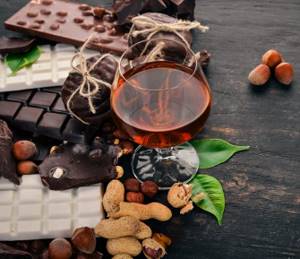
It is not the cognac itself that contributes to weight gain, but the snack that goes with it.
How to quickly come to your senses
It happens that during a feast, unforeseen circumstances arise when you need to get behind the wheel or take some actions that require attentiveness, concentration and speed of reaction. In such situations, you either have to look for a replacement, and if this is not possible, then urgently take measures to sober up and expedite the removal of alcohol from the body. Of course, there can be no talk of “just a couple more grams.”
To enhance the work of the liver and other organs to remove ethanol, it is necessary:
- Induce vomiting. Along with the mass, the remains of alcohol that has not yet been digested and absorbed into the blood will come out. To provoke the reflex, you will need to drink a large amount of water in one gulp (1-2 liters), and if it is stuck on nausea, then you need to press on the root of the tongue. Although many try to avoid the procedure, the body has not yet invented a better method of cleansing.
An excellent and proven remedy is ammonia. You can not only smell it to bring you to consciousness, but also drink it. 5-10 drops of solution per glass of water have an immediate effect: they induce vomiting, clear the brain, and dispel fog in the head. In short, they help you sober up faster and help remove alcohol from the blood. Take ascorbic acid (a dose of 2.5 g is required per 70 kg of weight). Drink as much as possible. Water enhances metabolism and the disposal of toxins. Plain water or acidified with lemon, fruit drinks, citrus juices, and weak tea will help.
Take regular or white activated carbon. It will bind toxins and speed up their release. You can drink a raw chicken egg. True, then you need to be sure that you don’t get salmonellosis. Otherwise, when solving one problem, you will end up with another – more dangerous one. Get a massage. Vigorous rubbing of the feet, palms and ears will increase blood circulation. This, in turn, will promote the rapid removal of toxins. As soon as your head clears, take a cool shower. It will disperse the blood and speed up the neutralization of toxins.
When drinking alcohol, you need to remember how much it wears off. Understanding this will help in planning matters, and will also protect you from emergency measures to remove it. But still, you shouldn’t take risks with drinking if you have work or actions that require attentiveness and speed of reaction. After all, alcohol is completely neutralized by the body within a few days. Therefore, plan your vacation so that you can get behind the wheel with a clear head. This will save you from troubles on the road, prevent accidents, and preserve your own health and the health of others, and even lives.
alcoholism.com
Calorie content of cognac and cola
In an effort to reduce the strength and calorie content of the drink, some people prefer to drink a cocktail of cognac and cola.
The calorie content of such a cocktail will depend on the proportion of ingredients.
If you mix cognac and cola in a glass in a 1:2 ratio, the calorie content of 100 grams of the drink will be 107 kcal.
So the drink will be not only low-alcohol, but also low-calorie.
Orange is an amazing low-calorie food. This citrus fruit has a pleasant smell and taste, which is why it is eaten fresh or cooked. The nutritional value of oranges totals .
People watching their weight know that bread is a high-calorie product and therefore try to consume it as little as possible. They have to calculate how many calories are in each piece they eat. .
Chicken eggs are not only a tasty and easy-to-prepare product that is affordable, but also a valuable supplier of various useful substances. If we describe the beneficial properties of this product,...
The human body is a complex mechanism, and sugar is a kind of “fuel” for its normal functioning. There are so many rumors and myths about sugar that it’s hard to figure it out.
Stuffed cabbage rolls are the most famous dish made from cabbage. Each housewife has her own recipe for preparing them, but traditionally cabbage rolls are prepared with minced meat. Nutritional value 100 grams.
Olya
Living deliciously is a whole science!
How to speed up the elimination of cognac
The question of whether it is possible to help the body cope with the consequences of drinking is of concern to everyone who needs to get in shape faster. Doctors are not encouraging: you will not be able to influence the rate of weathering.
But you can improve your well-being by taking the following measures:
- making yourself green tea with lemon, berry juice;
- by consuming 5-6 tablets of activated carbon with water;
- having a snack with cabbage soup or borscht.
Moderate physical activity (walking 3-4 kilometers through the park at a brisk pace) and a contrast shower help.
posamogonu.ru
Absolutely every driver has had a situation when it is necessary to go on a visit, to a birthday party, to a picnic with friends, to simply relax at sea, to attend a corporate event, to visit relatives, etc. And here a natural question arises: to drink or not to drink?! Here everyone decides for themselves.
I would like to consider in more detail the question of how long it takes for different types of alcohol to dissipate, whether it depends on weight, and whether there is a clear correlation with the amount drunk.
If you decide to drink 100 grams of beer, you must remember that it is eliminated from the body in 34 minutes if your weight is 60 kg, in 30 minutes if you weigh 70 kg, 27 minutes - 80 kg and 22 minutes if you weigh 90 kg.
If you drink 100 grams of vodka at a celebration, it will be excreted through your body in 5 hours 47 minutes with a weight of 60 kg, 5 hours 2 minutes with a weight of 70 kg, 4 hours 33 minutes with 80 kg and 3 hours 48 minutes with a weight of 90 kg, respectively. .
Cognac is excreted from the body based on 100 grams drunk: after 6 hours 12 minutes with a weight of 60 kg, 5 hours 24 minutes with a weight of 70 kg, 4 hours 45 minutes with 80 kg, 4 hours 25 minutes with 90 kg. Absinthe at a rate of 100 grams will take the longest to excrete. With a weight of 60 kg - after 6 hours 57 minutes, 70 kg - after 6 hours 45 minutes, 80 kg - after 6 hours 37 minutes, 90 kg - after 6 hours 30 minutes.
If you are female or simply prefer not so strong alcoholic drinks, then you need to take note that when you drink 100 grams of champagne, it will be eliminated from your body if you weigh 60 kg in 1 hour 37 minutes, if you weigh 70 kg - after 1 hour 24 minutes, 80 kg – 1 hour 11 minutes, 90 kg – after 1 hour 02 minutes.
About the drink
Cognac is a strong alcoholic drink that is made from selected selected grape varieties. The drink is named after the French city of Cognac, located in the Charente Valley. In addition to the official history of creation, there are many others. The name of the product also comes from the name of the Roman emperor, and the city of the same name is also located in Italy, where they love cognac very much.
Since ancient times, special grape varieties have been used to produce a strong drink - Folle Blanche and Montille, but after several epidemics the bushes suffered significantly. Currently, cognac is widely made from the Ugny Blanc variety.
The glassware for consumption is a spherical glass with a large bowl that is rounded at the top. The glass has a high stem and a volume of about 140-150 ml. It is not customary to cool or heat the product. The optimal temperature for serving cognac is room temperature. In Russia and the countries of the former USSR, since the mid-19th century, there has been a tradition of drinking alcohol with a slice of lemon.
Contraindications for cognac
This aromatic alcohol is not recommended for consumption when a person has hypotension (that is, low blood pressure). It is also not recommended for overweight people to indulge in this type of alcohol. Cognac is not always able to help a person normalize their health. This type of alcohol is strictly prohibited for the following types of diseases:
- diabetes;
- gallbladder pathology;
- liver and kidney diseases;
- hypertension (high blood pressure).
In case of too zealous passion for cognac, the onset of alcoholism is not far off, especially since this alcohol is distinguished by its strength and quickly becomes addictive
Therefore, such alcohol should be treated with special caution. It would not be out of place to mention that cognac is prohibited for expectant and nursing mothers
Cognac, like strong alcohol, has a destructive effect on the body of a pregnant woman and can completely destroy the health of the future baby. It should not be given to persons under 18 years of age, since this alcohol is considered potentially dangerous to the mental health of a young person whose nervous system is just in the process of maturation.
But this alcohol can be widely used in various culinary recipes. And, if taken in recommended safe quantities and not every day, good cognac can benefit a person. But only in case of moderate consumption of a drink produced by well-known manufacturers who strictly observe all the subtleties of the technological process.
vsezavisimosti.ru
A short excursion into history
The birthplace of cognac is sunny and sophisticated France. The history of the exquisite alcoholic drink began in the 1st century AD. From the moment when Roman soldiers brought grapes to French territory. The mild and warm climate of France came in handy, and the grapes took root well in the French provinces. Soon the French mastered winemaking, so successfully that by the 15th century large wine surpluses had formed.
Cognac is produced by distilling wine from certain grape varieties using special technology.
It is quite difficult to say exactly how noble alcohol first appeared. There are several legends of its origin. The two most common versions are:
- The culprit behind the birth of cognac was Chevalier De'La Croix, who came up with the idea of distilling fermented wine. He poured the resulting mass into an oak barrel and a few years later decided to try the drink he had learned. Having opened the container, the Chevalier was amazed that the liquid had become much smaller, but its color and taste were filled with amazing aromas.
- Once upon a time, French winemakers were unable to take away barrels filled with grape vodka for sale. They remained stored in the cellars and after some time, the winemakers noted with surprise that the drink not only did not deteriorate completely, but acquired previously unknown features, attractive in aroma and taste. This gave impetus to more detailed research and experiments on the creation of a new alcoholic drink - cognac.
It is not customary to drink this alcohol from ordinary glasses and glasses. Especially for refined alcohol, a “snifter” was created, a spherical glass with a narrowing at the top. It is not customary to drink an aromatic alcoholic drink in one gulp; it needs to be savored, imbued with the amazing aroma and plunged into the depths of the exquisite taste.
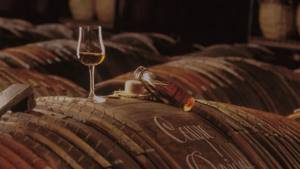
Cognac is made from grape wine aged for many years in oak barrels.
According to French traditions, cognac is considered a “digestif”, that is, a drink served at the end of a meal. And this alcohol is combined only with dark natural chocolate, coffee and a good cigar.
Drink classification
The highest demands are placed on the quality of this alcohol. All cognac, depending on the raw materials used in production and the aging period, is divided into three types:
- Single. To prepare such alcohol, cognac spirits are taken with a short aging period (3-4 years). Based on the aging period of single cognac, manufacturers label the drink with a certain number of stars. The strength of such alcohol varies between 40-41%. Remember that the older and more mature the single cognac, the richer and more intense its taste.
- Vintage. To produce alcohol of this level, raw materials are taken that have been aged for at least 6-7 years. Among vintage cognacs, a distinction is made between old, highly aged, high-quality and simply aged drinks. Their strength can reach up to 55-57%.
- Collectible. The only difference between cognac of this level and vintage is the aging period. For collectibles it reaches 11-12 years.

Classification of cognac
What is brandy
Speaking about the cognac world, one cannot fail to mention another name for this drink - “brandy”. In fact, brandy is no different from real cognac. But according to French law, “cognac” can only be called alcohol that is produced exclusively in one of the French regions - the province of Charente. If the product is produced using exactly the same technology, but in a different area, such a drink will be called “brandy”.
In terms of quality, it is absolutely not inferior to cognac. But there are no high requirements for its production, so producers can use a different grape variety and simplify the rest of the technological process.

